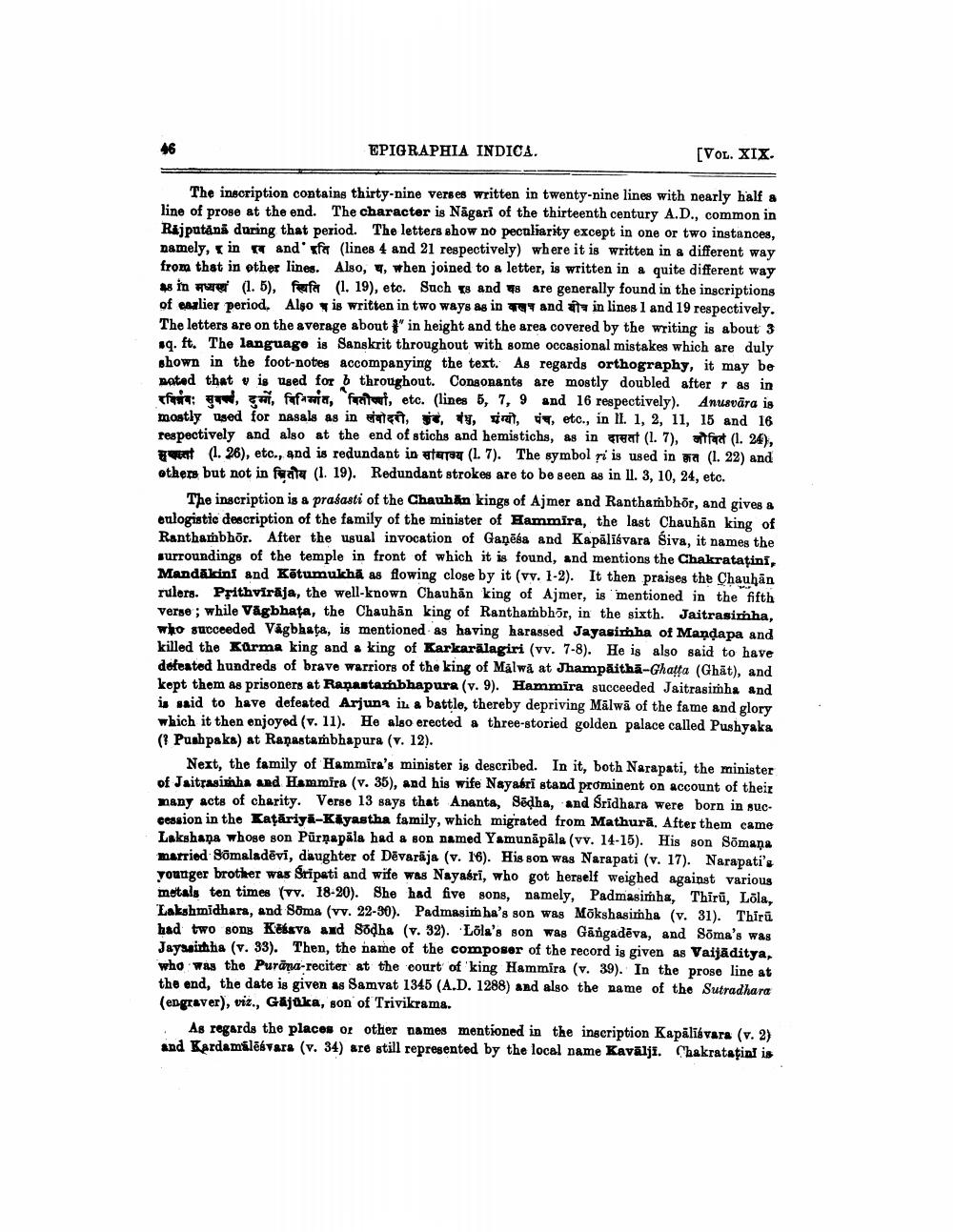________________
46
EPIGRAPHIA INDICA.
[VOL. XIX.
The inscription contains thirty-nine verses written in twenty-nine lines with nearly half a line of prose at the end. The character is Nagari of the thirteenth century A.D., common in Rajputana during that period. The letters show no peculiarity except in one or two instances, namely, in and fer (lines 4 and 21 respectively) where it is written in a different way from that in other lines. Also, , when joined to a letter, is written in a quite different way as in wure (1.5), farfa (1. 19), etc. Such xs and s are generally found in the inscriptions of earlier period. Also is written in two ways as in and at in lines 1 and 19 respectively. The letters are on the average about " in height and the area covered by the writing is about 3 sq. ft. The language is Sanskrit throughout with some occasional mistakes which are duly shown in the foot-notes accompanying the text. As regards orthography, it may be noted that is used for b throughout. Consonants are mostly doubled after r as in रविन सुवर्ण, दुम् विनित, बितीर्ष्या, etc. ( lines 5, 7, 9 and 16 respectively). Anusvāra is mostly used for nasals as in a, e, dy, i, d, etc., in II. 1, 2, 11, 15 and 16 respectively and also at the end of stichs and hemistichs, as in great (1. 7), afaret (1. 24), a (1. 22) and
at (1. 26), etc., and is redundant in tara (1. 7). The symbol ri is used in others but not in fata (1. 19). Redundant strokes are to be seen as in 11. 3, 10, 24, etc.
The inscription is a prasasti of the Chauhan kings of Ajmer and Ranthambhor, and gives a eulogistic description of the family of the minister of Hammira, the last Chauhan king of Ranthambhor. After the usual invocation of Ganesa and Kapalisvara Śiva, it names the surroundings of the temple in front of which it is found, and mentions the Chakrataţinî, Mandakini and Ketumukha as flowing close by it (vv. 1-2). It then praises the Chauhan rulers. Prithviraja, the well-known Chauhan king of Ajmer, is mentioned in the fifth verse; while Vägbhata, the Chauhan king of Ranthambhor, in the sixth. Jaitrasimha, who succeeded Vägbhata, is mentioned as having harassed Jayasimha of Manḍapa and killed the Karma king and a king of Karkarälagiri (vv. 7-8). He is also said to have defeated hundreds of brave warriors of the king of Malwa at Jhampaitha-Ghaṭṭa (Ghat), and kept them as prisoners at Rapastarbhapura (v. 9). Hammira succeeded Jaitrasimha and is said to have defeated Arjuna in a battle, thereby depriving Malwa of the fame and glory which it then enjoyed (v. 11). He also erected a three-storied golden palace called Pushyaka (? Pushpaka) at Rapastambhapura (v. 12).
Next, the family of Hammira's minister is described. In it, both Narapati, the minister of Jaitrasimha and Hammira (v. 35), and his wife Nayaéri stand prominent on account of their many acts of charity. Verse 13 says that Ananta, Sedha, and Sridhara were born in suc cession in the Katariya-Kayastha family, which migrated from Mathura. After them came Lakshana whose son Purnapala had a son named Yamunapala (vv. 14-15). His son Sōmaņa married Sōmaladevi, daughter of Devaraja (v. 16). His son was Narapati (v. 17). Narapati's younger brother was Sripati and wife was Nayasri, who got herself weighed against various metals ten times (vv. 18-20). She had five sons, namely, Padmasimha, Thiru, Lōla, Lakshmidhara, and Soma (vv. 22-30). Padmasimha's son was Mokshasimha (v. 31). Thirü had two sons Kesava and Sodha (v. 32). Lola's son was Gangadeva, and Soma's was Jaysaithha (v. 33). Then, the name of the composer of the record is given as Vaijäditya, who was the Purana-reciter at the court of king Hammira (v. 39). In the prose line at the end, the date is given as Samvat 1345 (A.D. 1288) and also the name of the Sutradhara (engraver), viz., Gajaka, son of Trivikrama.
As regards the places or other names mentioned in the inscription Kapalisvara (v. 2) and Kardamalēsvara (v. 34) are still represented by the local name Kavalji. Chakratațini is




